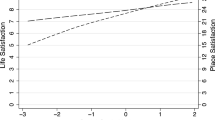Abstract
The stress-threshold model (Wolpert, 1965; Brown and Moore, 1970) assumes that people do not consider moving unless they experience residential stress. This paper develops a similar model of residential mobility in which residential satisfaction acts as an intervening variable between individual and residence variables and mobility. The model is tested with data from a panel study of Rhode Island residents. The results indicate that residential satisfaction at the first interview is related to the wish to move and to mobility in the year following the interview. Individual and residence characteristics such as age of head duration of residence, home ownership, and room crowding are shown to affect mobility through their effect on residential satisfaction.
Similar content being viewed by others
References
Blumen, Isadore, Marvin Kogan, and Philip J. McCarthy. 1955. The Industrial Mobility of Labor as a Probability Process. Cornell Studies in Industrial and Labor Relations, Vol. VI. Ithaca: Cornell University Press.
Brown, Lawrence A., and John Holmes. 1971. Intra-Urban Migrant Lifelines: A Spatial View. Demography 8:103–122.
—, and David B. Longbrake. 1970. Migration Flows in Intra-Urban Space: Place Utility Considerations. Annals of the Association of American Geographers 60:368–384.
—, and Eric G. Moore. 1970. The Intra-Urban Migration Process: A Perspective. Geografiska Annaler, Series B 52: 1–13.
Butler, Edgar W. 1970. Theoretical Issues in the Utilization of Areal, Demographic, and Social Psychological Dimensions in Migration Research. Unpublished paper presented at the NICHD Conference on Migration Histories, Washington, D.C., February 5–6, 1970.
—, F. Stuart Chapin, Jr., George C. Hemmens, Edward J. Kaiser, Michael A. Stegmann, and Shirley F. Weiss. 1969. Moving Behavior and Residential Choice-A National Survey. National Cooperative Highway Research Program, Report No. 81. Washington, D.C.: Highway Research Board, National Academy of Sciences.
Clark, W. A. V. 1970. Measurement and Explanation in Intra-urban Residential Mobility. Tijdschrift Voor Economische en Sociale Geografie 60:49–58.
Golant, Stephen M. 1971. Adjustment Process in a System: A Behavioral Model of Human Movement. Geographical Analysis 3: 203–220.
Goldstein, Sidney. 1958. Patterns of Mobility, 1910–1950. Philadelphia: University of Pennsylvania Press.
—. 1964. The Extent of Repeated Migration: An Analysis Based on the Danish Population Register. Journal of the American Statistical Association 59:1121–1132.
Kendall, M. G., and A. Stuart. 1958. The Advanced Theory of Statistics. Vol. 2. London: Charles Griffin.
Land, Kenneth C. 1969. Duration of Residence and Prospective Migration: Further Evidence. Demography 6:133–140.
Lansing, John B., and Eva Mueller. 1967. The Geographic Mobility of Labor. Ann Arbor: Institute for Social Research.
Lee, Everett S. 1966. A Theory of Migration. Demography 3:47–57.
McGinnis, Robert. 1968. A Stochastic Model of Social Mobility. American Sociological Review 33:712–722.
Morrison, Peter A. 1967. Duration of Residence and Prospective Migration: The Evaluation of a Stochastic Model. Demography 4:553–561.
—. 1971. Chronic Movers and the Future Redistribution of Population. Demography 8:171–184.
—. 1972. Population Movements and the Shape of Urban Growth: Implications for Public Policy. R-1072-CPG. Santa Monica: The Rand Corporation.
Myers, George C., Robert McGinnis, and George Masnick, 1967. The Duration of Residence Approach to a Dynamic Stochastic Model of Internal Migration: A Test of the Axiom of Cumulative Inertia. Eugenics Quarterly 14:121–126.
Organic, Harold, and Sidney Goldstein. 1970. The Brown University Population Research Laboratory: Its Purposes and Initial Progress. Pp. 212–232 in Irving I. Kessler and Morton L. Levin (eds.), The Community as an Epidemiologic Laboratory. Baltimore: Johns Hopkins Press.
Rossi, Peter H. 1955. Why Families Move: A Study in the Social Psychology of Urban Residential Mobility. New York: The Free Press.
Sabagh, Georges, Maurice van Arsdol, Jr., and Edgar Butler. 1969. Some Determinants of Intrametropolitan Residential Mobility: Conceptual Consideration. Social Forces 48: 88–98.
Simmons, J. W. 1968. Changing Residence in the City: A Review of Intra-urban Mobility. Geographical Review 58:622–651.
Simon, Herbert A. 1957. Models of Man. New York: John Wiley and Sons, Inc. Sjaastad, Larry A. 1962. The Costs and Returns of Human Migration. Journal of Political Economy. 70(5, part 2):80–93.
Speare, Alden, Jr. 1970. Home Ownership, Life Cycle Stage, and Residential Mobility. Demography 7:449–458.
— 1971a. A Cost-Benefit Model of Rural to Urban Migration in Taiwan. Population Studies 25:117–130.
Speare, Alden, Jr. 1971b. Alternative Models of Individual Mobility. Pp, 364–368 in Proceedings of the American Statistical Association, Social Statistics Section.
Stone, Leroy O. 1971. On the Analysis of the Structure of Metropolitan Area Migration Streams. Educational Planning Occasional Paper No. 1171. Toronto: Department of Educational Planning, Ontario Institute for Studies in Education.
van Arsdol, Maurice D., Jr., Georges Sabagh, and Edgar W. Butler. 1968. Retrospective and Subsequent Metropolitan Residential Mobility. Demography 5:249–267.
Wolpert, Julian. 1965. Behavioral Aspects of the Decision to Migrate. Papers of the Regional Science Association 15:159–169.
—. 1966. Migration as an Adjustment to Environmental Stress. Journal of Social Issues 22:92–102.
Author information
Authors and Affiliations
Rights and permissions
About this article
Cite this article
Speare, A. Residential satisfaction as an intervening variable in residential mobility. Demography 11, 173–188 (1974). https://doi.org/10.2307/2060556
Issue Date:
DOI: https://doi.org/10.2307/2060556




